Physical Address
304 North Cardinal St.
Dorchester Center, MA 02124
Embryonal tumors of the central nervous system (CNS) manifest as highly cellular, poorly differentiated, and mitotically active neoplasms that are reminiscent of the developing embryonic nervous system. Such tumors constitute the most common group of malignant pediatric brain tumors. Often referred to as “small blue cell tumors,” they are biologically aggressive and have a tendency to disseminate along cerebrospinal fluid (CSF) pathways. This group includes the medulloblastoma (the most common malignant brain tumor of childhood), the atypical teratoid/rhabdoid tumor (AT/RT), the embryonal tumor with multilayer rosettes, and a spectrum of other CNS embryonal tumors that were previously called “CNS primitive neuroectodermal tumors (PNETs).”
In a major change in classification from the first edition of this textbook, medulloblastomas are currently defined by the World Health Organization (WHO) according to well-validated and clinically relevant molecular characteristics as well as histologic features using an integrated diagnosis. Transciptome profiling studies helped to identify four clinically relevant groups including: WNT-activated (10% of cases), SHH (sonic hedgehog pathway)–activated (30%; later further divided into TP53 -wildtype and TP53 -mutant subsets), and two types of non-WNT/non-SHH medulloblastomas refered to as “group 3” (20%) and “group 4” (40%). These molecular subtypes occur within established histologic variants of medulloblastoma, which are retained because of their continued clinical relevance and include the desmoplastic/nodular, extensive nodularity, large cell/anaplastic, and “classic” histologic variants.
The discovery of a characteristic molecular alteration (amplification and fusions of the C19MC locus on chromosome 19q13.42) in tumors previously classified as ependymoblastoma, embryonal tumor with abundant neuropil and true rosettes (ETANTR), and a subset of medulloepitheliomas has led to the current unified diagnostic term: “embryonal tumor with multilayered rosettes (ETMR), C19MC-altered.” The term “CNS PNET” has been replaced by “other CNS embryonal tumors” to describe the rare cerebral neuroblastoma, ganglioneuroblastoma, and medulloepitheliomas not having the C19MC alteration, as well as the “CNS embryonal tumor, NOS” reserved for examples that either haven't undergone molecular characterization or don't fall neatly into any of the more clearly defined subtypes. The pineoblastoma, a CNS embryonal tumor variant of the pineal gland (WHO grade IV pineal parenchymal tumor), is covered in Chapter 11 . Although rare, a meningeal form of peripheral nervous system (PNS) small blue cell tumor (Ewing sarcoma) also exists; these may be difficult to distinguish from CNS embryonal neoplasms and other small blue cell tumors without ancillary molecular studies to detect EWSR1 gene rearrangements, the classic t(11,22) translocation, or other variant translocations and their fusion products via karyotyping, fluorescence in situ hybridization (FISH), or RT-PCR. Although also useful, one should not rely too heavily on strong and diffuse membrane CD99 immunoreactivity, since it can also be seen in other cellular meningeal neoplams (e.g., solitary fibrous tumor/hemangiopericytoma; see Chapter 14 ) and some of the CNS embryonal neoplasms, such as AT/RT. Novel subtypes of CNS embryonal tumors have also been recently described since the WHO scheme was published, using advanced molecular profiling methods. The key features of the embryonal tumors discussed in this chapter are summarized in Table 12.1 .
| Tumor Type | Age a | Location (Typical) | Predominant Histology | Ancillary Studies/Distinctive Features | Major Molecular Alterations | Prognosis |
|---|---|---|---|---|---|---|
| Medulloblastoma | ||||||
| WNT-activated (10%) | Childhood |
|
Classic |
|
|
Good |
| SHH-activated (30%) TP53 -wildtype TP53 -mutant |
|
|
|
|
|
|
| Non-WNT/non-SHH Group 3 (20%) |
|
Midline or lateral cerebellum |
|
Features of anaplasia: increased nuclear size, pleomorphism, numerous mitoses with atypical forms, cell “wrapping” |
|
Poor |
| Non-WNT/non-SHH Group 4 (40%) |
|
|
Classic |
|
|
Intermediate risk |
| ETMR, C19MC-Altered | Infancy and early chilhood |
|
Highly variable histology with distinctive multilayered rosettes and variable neuropil-like areas | LIN28A positive | C19MC amplification and/or fusions | Poor |
| Other CNS Embryonal Tumors | Infancy to young adult | Cerebral hemispheres (Rare: brainstem, spinal cord, suprasellar) | Poorly differentiated embryonal tumors | Spectrum of neuronal and glial differentiation by IHC | MYCN amplification | Poor |
| Atypical Teratoid/Rhabdoid Tumor (AT/RT) | Infancy |
|
|
|
|
Poor |
Lastly, the tumor designated “cerebral neuroblastoma” should be distinguished from the pediatric peripheral neuroblastomas of adrenal and sympathetic PNS origin, although this is usually easily achieved by simply considering tumor localization.
The nosology of CNS embryonal tumors has often been controversial among experts and confusing for practitioners and students. The first widely used brain tumor classification scheme was that of Bailey and Cushing who introduced the term medulloblastoma to describe “…a very cellular tumor of peculiar kind” that arose in the cerebellum of children. They also recognized that microscopically similar neoplasms could arise elsewhere in the CNS, and subsequently, names such as “cerebral neuroblastoma,” “medulloepithelioma,” and “ependymoblastoma” were used to describe such tumors based on their location in the brain and on subtle aspects of their histopathology. These terms were based on theoretical or putative pluripotential cells of origin (e.g., “medulloblast”) that had not been clearly identified or defined. The search for genetically defined subtypes of cells that may give rise to embryonal nervous system tumors is ongoing.
The prior concept of CNS PNETs was introduced by Hart and Earle to describe a group of poorly differentiated cerebral tumors that could not be readily placed into more specific diagnostic categories. This concept was then expanded by Rorke who proposed the use of PNET to include the full spectrum of CNS embyronal tumors that were characterized by high cellularity, brisk mitotic activity, and a “small blue cell” histologic appearance, regardless of location in the CNS. Implicit in this scheme was the belief that terms like medulloblastoma, ependymoblastoma, or pineoblastoma were based entirely on hypothetical and undefined cells of origin, whereas the less committal term PNET could be used until more was learned about the biology and molecular features of these tumor types. Included in this proposed scheme of PNETs were cerebellar medulloblastomas and all other forms of cerebral PNETs, including pineoblastoma.
Over the past decade, remarkable advances in the molecular characterization of CNS embryonal tumors, along with a better understanding of their biology and natural history, have led to the current classification system, which uses molecular characteristics as well as histologic features to provide the most clinically relevant information to those caring for and treating patients. The designations used in this chapter correspond to the 2016 WHO classification of CNS tumors. The term “PNET” is no longer used to refer to CNS small blue cell tumors, and the favored term currently is “CNS embryonal tumor, NOS” for cases that do not conform to more specific diagnostic entities.
Medulloblastoma is defined by the WHO as “an embryonal neuroepithelial tumor arising in the cerebellum or dorsal brainstem, presenting mainly in childhood and consisting of densly packed small round undifferentiated cells with mild to moderate nuclear pleopmorphism and a high mitotic count.” Furthermore, it is now expected that the integrated WHO diagnosis include both the histopathologic and the molecular variants, as they represent biologically distinct subtypes within the umbrella designation of “medulloblastoma” (see later discussions).
Medulloblastoma is the most common CNS embryonal tumor, representing over 90% of all cases. Having an estimated annual childhood incidence of 0.6/100,000, it accounts for 25% of all pediatric brain tumors. More than 77% of medulloblastomas occur before the age of 19 years, with a bimodal peak incidence between 3 to 4 years and 8 to 9 years of age. Infants account for about 10% to 15% of cases. Males are affected more than females by a ratio of about 2 to 1 in children greater than 3 years of age, while there is no sex predilection for patients less than 3 years of age. The propensity for these tumors to disseminate within the subarachnoid space of the spine and brain remains a significant therapeutic challenge. About 30% of patients have CSF metastases at presentation. Adult cases are less common, accounting for less than 1% of brain tumors and mostly occurring in patients between the ages of 21 and 40 years. The tumor is rare beyond the fifth decade. Variations in incidence and demographics for molecular groups and histologic variants will be discussed later in the chapter.
About 80% of medulloblastomas arise in the cerebellar midline (inferior vermis) where they typically project into and fill the fourth ventricle ( Fig. 12.1A ). This usually results in hydrocephalus above the level of obstruction. A smaller proportion of medulloblastomas occur in one of the cerebellar hemispheres ( Fig. 12.1B ), and in such cases, patients tend to be older (adolescents or young adults) and the desmoplastic/nodular histologic variant predominates (discussed later). Origin from the dorsal brainstem (often with involvement of the middle cerebellar peduncle) is believed to occur in the WNT-activated medulloblastoma. Invasion of adjacent brainstem structures including vital cardiorespiratory centers of the fourth ventricular floor limit the extent of tumor resection. The tendency of medulloblastoma to spread via CSF pathways can lead to diffuse “sugar coating,” or “icing,” of the subarachnoid space or produce nodular growths along the lower spinal cord and nerve roots (“drop metastases”) or even the ventricular surfaces ( Fig. 12.1C ). In contrast to CSF spread, systemic metastases to bone and bone marrow, lymph nodes, and visceral organs are exceptional ( Fig. 12.1D ). Occasional tumors have found their way outside of the nervous system via ventriculoperitoneal shunts or other iatrogenic means.
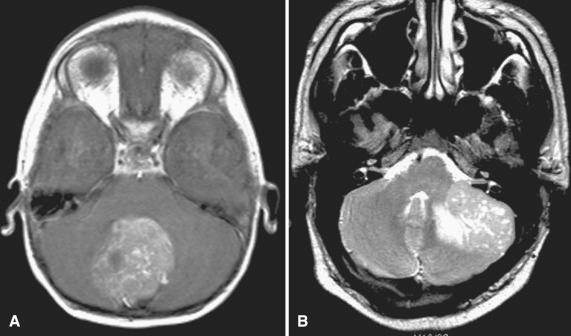
Symptoms and signs are those of an expanding posterior fossa mass and include headaches, nausea/vomiting, and ataxia. Papilledema may result from hydrocephalus and increased intracranial pressure. The development of cerebellar tonsillar herniation may be accompanied by neck pain. Meningeal irritation due to spread of tumor in the subarachnoid space may lead to neck stiffness and head tilt. Spinal metastases can result in focal deficits at a spinal cord level or nerve root pain. Infants with medulloblastoma often present with less specific signs, such as failure to thrive, vomiting, and irritability.
Medulloblastomas appear as expansile, noncalcified mass lesions of the fourth ventricle or cerebellar hemisphere on imaging studies. Magnetic resonance imaging (MRI) typically reveals a fourth ventricular neoplasm that is hypointense on T1-weighted, hyperintense on T2-weighted, and brightly enhancing on postcontrast T1-weighted images (see Fig. 12.1A ). Tumors are usually solid with only occasional cyst formation or little apparent necrosis. Highly cellular tumors like medulloblastoma characteristically show restricted diffusion on diffusion-weighted MRI. The less common cerebellar hemispheric tumors of older children and adults show similar imaging features ( Fig. 12.1B ), except that contrast enhancement is more variable. Extensive nodularity may occur in an early childhood subtype of medulloblastoma and is further discussed in the section on Histologic Variants and Grading .
Grossly, medulloblastomas are soft, fleshy, pink-gray tumors with variable hemorrhage and sometimes necrosis. Desmoplastic variants tend to be firm. Infiltration of the meninges and subarachnoid space may be apparent, as well as frank invasion of adjacent structures.
The usual or classic type of medulloblastoma features a highly cellular, mostly patternless proliferation of cells with small to midsize hyperchromatic nuclei and little apparent cytoplasm ( Fig. 12.2A ). At low magnification, there is often a mixed solid and infiltrative growth pattern. Molding of the nuclei is often conspicuous due to high cell density and there is variable nuclear pleomorphism, although the latter is usually not marked except in the anaplastic variant (see next section). Nucleoli are not prominent except in the large cell variant, in which this is a defining feature (see next section). Mitoses are usually plentiful, as is the necrosis of individual cells in the form of nuclear fragmentation or karyorrhexis ( Fig. 12.2B ). Larger foci of tumor necrosis may be present, but only rarely show the classic palisading pattern that is more commonly found in glioblastoma. Vascular endothelial proliferation is similarly unusual, but does not exclude the diagnosis.
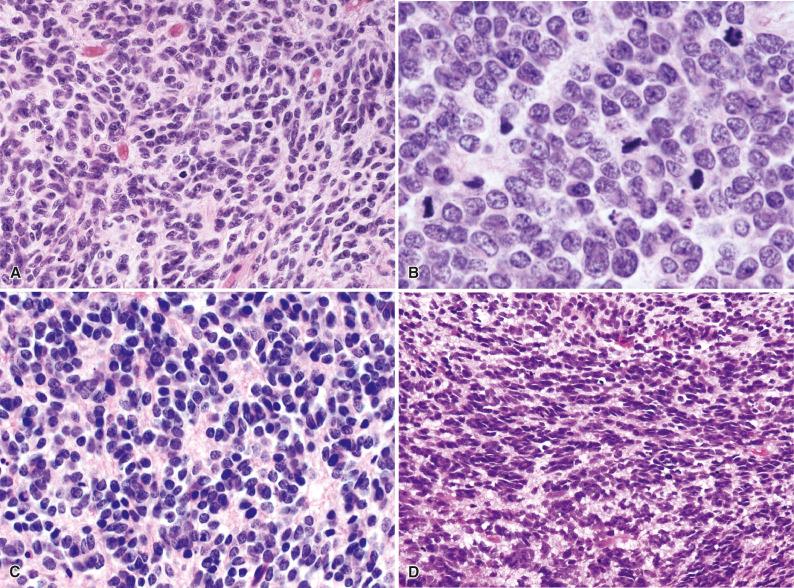
As stated earlier, medulloblastomas are multipotent, although neuronal differentiation is by far the most common lineage represented and nearly all cases show at least limited evidence of this type of maturation. A few clues may be apparent on hematoxylin and eosin staining, though confirmation usually requires immunohistochemical studies. Homer Wright (neuroblastic) rosettes are found in about 40% of cases and are characteristic of the classic variant of medulloblastoma ( Fig. 12.2C ). However, such structures may be subtle or absent and are therefore not required for diagnosis. “Streaming” linear arrays or parallel rows of neoplastic cells are occasionally present ( Fig. 12.2D ), often being most pronounced in the desmoplastic/nodular variant. Nodular foci of tumor may present a less cellular, more “differentiated” character that often includes neurocytes (small, mature oligodendroglioma-like nuclei with clear haloes or minimal cytoplasm set within a delicate neuropil matrix), but only rarely includes mature-appearing ganglion cells (see section “ Desmoplastic/Nodular Medulloblastoma ”).
Intra-axial tumor spread may occur by subpial infiltration of tumor cells, leading to an appearance that is somewhat reminiscent of the developmental external granule cell layer ( Fig. 12.3A ). However, this histologic resemblance is only “superficial” as the invasive tumor frequently extends to other adjacent structures, especially into the subarachnoid space, often with extension back into the cerebellar parenchyma along perivascular Virchow-Robin spaces (“re-entry” pattern) ( Fig. 12.3B ).
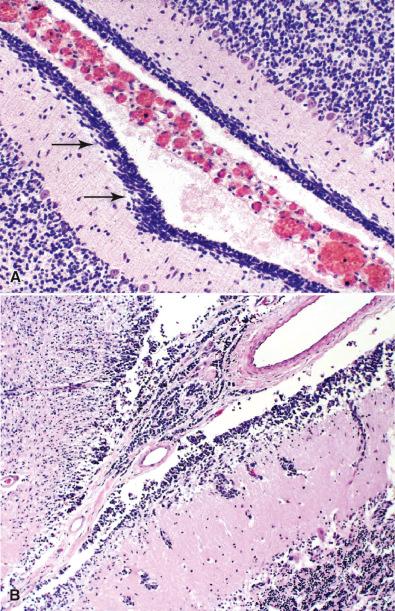
Several points deserve mention concerning diagnostic considerations during intraoperative consultation. Touch or squash preparations are better at preserving cytologic features and show large numbers of loosely cohesive cells with hyperchromatic nuclei and granular chromatin ( Fig. 12.4A ). Frozen section also shows a highly cellular, mitotically active tumor and, occasionally, Homer Wright rosettes or nodular architecture. However, an important pitfall to avoid is that in any biopsy of the posterior fossa, native granule cell (GC) neurons may falsely suggest a “small round blue cell” appearance, having hyperchromatic nuclei that are about the size of a mature lymphocyte nucleus (7 µm), with little or no discernable cytoplasm ( Fig. 12.4B ). In contrast, the neoplastic nuclei of medulloblastomas are usually substantially larger and the identification of mitotic figures or nuclear karryorhexis further aids in distinguishing tumor from GC neurons. Also, in sections of cerebellar cortex, the GC layer typically shows a regular distribution of cells with intervening clear-staining foci corresponding to the synapses of ascending mossy fibers and GC dendrites (see Chapter 2 ). In well-oriented tissue sections, the GC layer is sharply demarcated from the adjacent Purkinje cell and hypocellular molecular layer, although infiltrating tumor can disrupt this normal architecture. As always, correlation of histology with imaging findings that provide the location and character of the lesion (solid vs. cystic vs. mural nodule) greatly aids diagnostic interpretation at the time of intraoperative consultation.
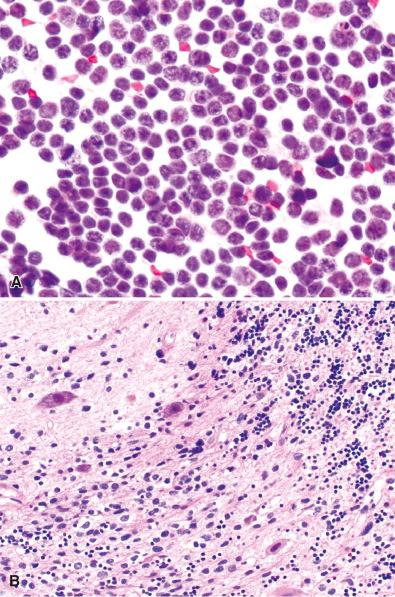
All medulloblastomas are highly malignant tumors and are thus classified as WHO grade IV. Although the majority of medulloblastomas have the classic histopathology described earlier, several variants, which have distinct clinical as well as microscopic characteristics, are discussed here. As stated earlier, it is now recommended that both the histologic variant and the molecular subtype be listed together within a single integrated diagnosis. It should also be noted that the classic type medulloblastomas may also contain focal nodular or large cell or anaplastic features that should be documented in the pathology report. However, the variants described next are those in which these features predominate.
Desmoplastic/nodular medulloblastomas account for about 20% of all medulloblastomas and 50% of medulloblastomas in children less than 3 years of age. Also referred to as “desmoplastic medulloblastoma,” this variant is more likely to arise in a cerebellar hemisphere, rather than within the fourth ventricle (see Fig. 12.1B ). It contains conspicuous foci of differentiation, characterized by weakly proliferative, reticulin-free nodules (so-called “pale-islands” due to increased cytoplasm and neuropil formation) set within an intervening background of highly cellular, proliferatively active, reticulin-rich tumor ( Fig. 12.5A and B ). Thus, the histologic criteria for this variant require that both reticulin-rich internodular and reticulin-poor intranodular foci be present.
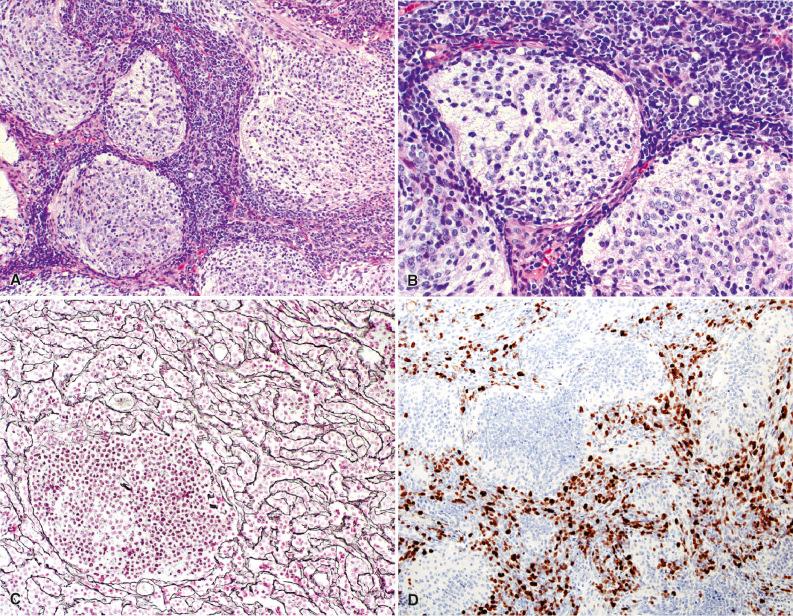
Desmoplasia manifests as fine intercellular reticulin deposition that tends to arrange tumor cells into cords, trabeculae, or small clusters ( Fig. 12.5C ). Tumor cells in reticulin-rich areas are mitotically active and show high MIB-1 (Ki-67) labeling indices by immunohistochemistry compared with the low levels of proliferative activity displayed by the reticulin-free nodules ( Fig. 12.5D ). The nodules also display a more differentiated phenotype using neuronal (e.g., synaptophysin, NeuN ) and to a lesser extent glial (e.g., glial fibrillary acidic protein [GFAP]) markers ( Fig. 12.5E and F ). Desmoplastic/nodular medulloblastomas often show mutations of PTCH1, SMO, and SUFU that lead to abnormal activation of the SHH pathway, which can usually be identified by surrogate immunostains such as GAB1 ( Fig. 12.6D ; discussed further in the section “Genetically Defined Medulloblastoma Groups”).
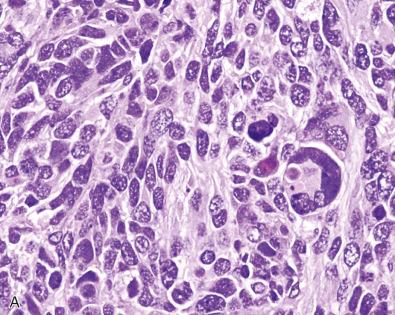
Another distinctive medulloblastoma variant, medulloblastoma with extensive nodularity (MBEN), occurs almost exclusively in infants and presents an exaggerated or extreme degree of desmoplastic/nodular architecture, such that reticulin-free pale areas predominate ( Fig. 12.7B–D ). When the nodules are particularly large, the tumor may show a peculiar grape-like radiologic or gross appearance ( Fig. 12.7A ). Extensive areas of the tumor show evidence of advanced neuronal (as well as astrocytic) differentiation, most often in the form of neurocyte-like cells within a neuropil-rich background ( Fig. 12.7C ). This variant, previously described as cerebellar neuroblastoma given its resemblance to differentiating neuroblastoma in the PNS, accounts for less than 3% of all medulloblastomas and is associated with a good prognosis, especially as compared with the generally poor clinical outcomes of patients with medulloblastomas who are younger than 3 years of age. Like the desmoplastic nodular variant of medulloblastoma, the extensively nodular variant carries mutations of genes in the SHH pathway. Occasional examples have been noted to undergo complete gangliocytic maturation after chemotherapy or radiation ( Fig. 12.7D ).
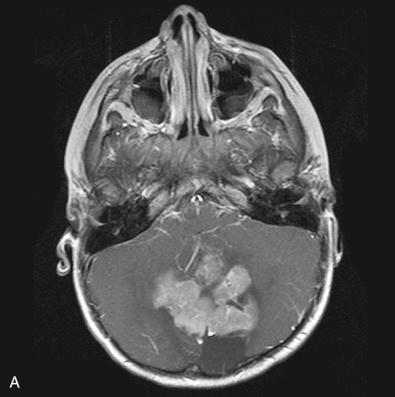
A variant of cerebellar medulloblastoma composed of large neoplastic cells with vesicular nuclei and prominent nucleoli ( Fig. 12.8A ) was first described by Giangaspero and colleagues. This “large cell” variant accounts for approximately 2% to 4% of all medulloblastomas and can be demonstrated to exhibit neuronal differentiation by immunohistochemical detection of neuronal lineage antigens such as synaptophysin. It strongly expresses INI1 (BAF47) ( Fig. 12.9D ), thus distinguishing this tumor type from the atypical teratoid/rhabdoid tumor (AT/RT), which typically shows loss of expression for this antigen. The large cell variant of medulloblastoma has been documented to have more aggressive biologic behavior and is less responsive to standard therapies. Areas of large cell histology can coexist with more typical small blue cell areas within any of the recognized histologic subtypes (classic, desmoplastic/nodular, medulloblastoma with myogenic features, etc.) ( Fig. 12.8B ).
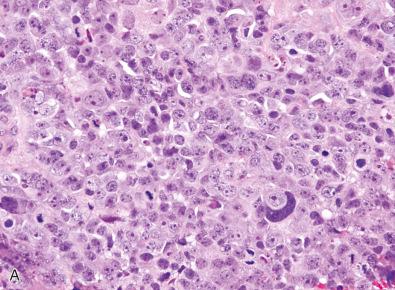
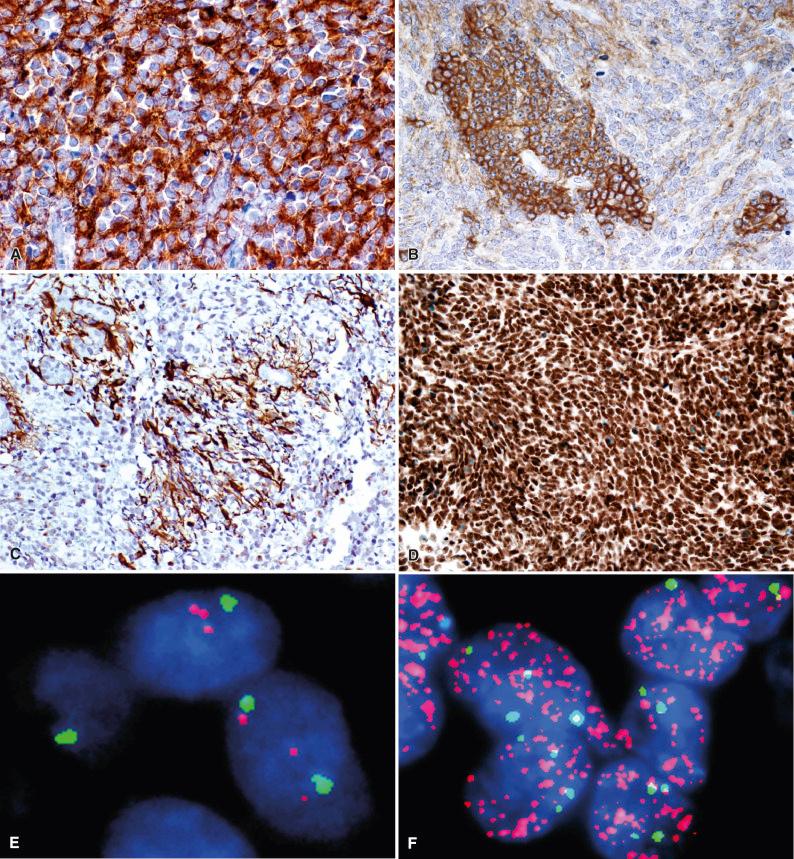
Histologic anaplasia of medulloblastomas has been defined as increased nuclear size with more striking nuclear pleomorphism and molding than the classic type; high mitotic activity with atypical forms; apoptotic bodies; and a distinctive wrapping of one tumor cell around another ( Fig. 12.8C and D ). In severe examples of anaplasia, one may encounter bizarre multinucleated cells, some of which are involved in “cannibalism” wherein a tumor cell phagocytizes its neighbors ( Fig. 12.8E ). Up to 15% of medulloblastomas may be dominated by these features and are called “anaplastic medulloblastomas,” which are also biologically aggressive. Both the large cell and anaplastic variants frequently show high levels of apoptosis of individual cells and also coalescing of these dying cells into “apoptotic lakes” ( Fig. 12.8F ), which are distinct from foci of coagulative necrosis. Variable degrees of anaplasia may be encountered in even classic medulloblastomas. Histologic transformation of more typical types of medulloblastoma to an anaplastic type is well documented. Because large cell and anaplastic features often coexist and have similar genetic characteristics and biologic implications, the combined term large cell/anaplastic medulloblastoma has been widely used and is now included as a single variant in the WHO 2016 scheme.
Rare medulloblastoma variants show evidence of skeletal muscle or melanocytic (or more often retinal pigmented epithelial) differentiation. The former, previously called medullomyoblastoma, contains scattered rhabdomyoblasts or mature skeletal muscle cells with variable pink cytoplasm and cross striations ( Fig. 12.10A ); such cells are immunoreactive for desmin and other skeletal muscle antigens ( Fig. 12.10B ). Medulloblastomas with melanotic differentiation ( Fig. 12.10C and D ) were previously known as melanotic medulloblastoma, with occasional examples featuring both myogenic and melanotic differentiation. These are now considered merely morphologic patterns, since there is no clear clinical significance to these findings. Even rarer forms of differentiation include other retinal elements, cartilage, bone, and epithelium. The limited data on the natural history of these tumors thus far suggest a similar biologic behavior to more typical medulloblastoma types.
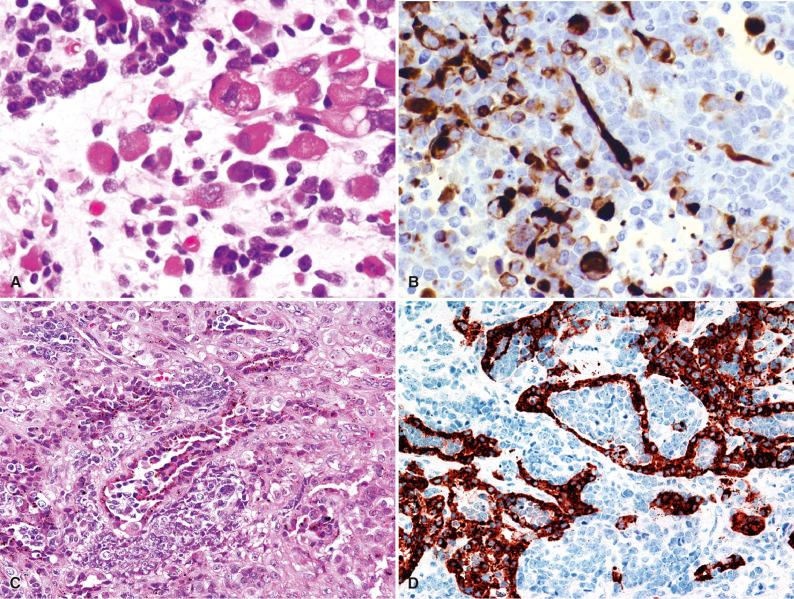
In addition to the histologic variant, it is now important to also list the molecular subtype, as outlined in the following discussion, within the integrated WHO diagnosis for each case. The most common cytogenetic aberration, identified in 40% to 50% of medulloblastomas, is a loss of the short arm of chromosome 17 (17p). This is often accompanied by duplication of the long arm, resulting in an isochromosome 17q (see Fig. 12.9E ). Candidate tumor suppressor genes on 17p include TP53, HIC1, and KCTD11. The last gene has been shown to inhibit sonic hedgehog signaling, which regulates cerebellar granular cell (GC) proliferation and may be involved in medulloblastoma tumorigenesis (see later discussion). Although some studies suggest an association between chromosome 17p loss and a poor prognosis, others have not. Additionally, more recent studies suggest that most examples represent an isodicentric 17q wherein the cytogenetic break is near rather than within the centromere, thus resulting in two closely apposed centromeres. In either case however, medulloblastomas with this alteration typically fall into the group 3 or 4 non-WNT, non-SHH molecular groups (see upcoming discussion).
About 10% of medulloblastomas have activation of the WNT signaling pathway, virtually all of which involve the dorsal brainstem/middle cerebellar peduncle ( Fig. 12.11A ) and show classic histologic features as described, although some are surprisingly infiltrative and may thus mimic a diffuse glioma ( Fig. 12.11B ). A useful immunohistochemical surrogate for WNT activation is the translocation of β-catenin from the cytoplasm to the nucleus in tumor cells ( Fig. 12.11C ), a finding which may only be focal at times. Transport of β-catenin to the nucleus results in activation of nuclear transcription factors that promote proliferation. WNT-activated tumors typically show “classic” medulloblastoma histology, although large cell/anaplastic morphology is also seen in rare examples. Around 90% of medulloblastomas showing WNT pathway activation also have monosomy of chromosome 6 and CTNNB1 mutation, either of which can provide valuable corroborating genetic confirmation given that β-catenin immunohistochemistry can be hard to interpret at times. Other mutations reported in these tumors include DDX3X, SMARCA4, and TP53. As stated earlier, such tumors are believed to arise from the dorsal brainstem. Patients with WNT-activated medulloblastomas are typically children or young adults (i.e., noninfants) and have an overall excellent prognosis with surgery and adjuvant chemotherapy. In fact, given the nearly 100% survival times in these patients, there has been a push for less aggressive therapy in order to minimize long-term complications.
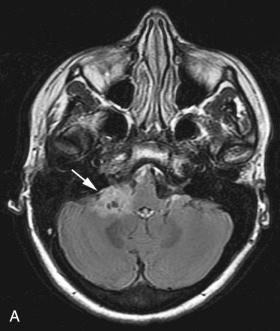
Some patients with germline mutations of the adenomatous polyposis (APC) gene develop medulloblastoma in addition to their predisposition to colon cancer (familial adenomatous polyposis, FAP). The APC protein normally inhibits the WNT pathway, thus promoting tumorigenesis through an alternate mechanism. Turcot syndrome includes two separate autosomal dominant conditions that predispose patients to malignant tumors of the colon and brain (see Chapter 22 ). Patients with one form of Turcot syndrome (type 2) have germline mutations of the APC gene on chromosome 5q21-q22 that predispose them to colon cancer and medulloblastoma. One study suggested that APC and CTNNB1 gene mutations are mutually exclusive.
Meduloblastomas with sonic hedgehog (SHH) pathway activation comprise another distinct molecular subtype with important clinical implications. Such tumors account for about 30% of medulloblastomas and, within this group, tumors may be either TP53 mutated or TP53 wildtype.
SHH-activated and TP53-mutant medulloblastomas may also have MYCN and GLI2 mutations as well as chromosome 17p loss. While nodular/desmoplastic histology may be seen, about two-thirds of cases will show anaplasia (see Fig. 12.6A ). Such tumors are rare and tend to occur within the ages of 4 and 17 years. The prognosis for patients with the SHH-activated and TP53-mutant medulloblastoma is poor. In contrast, the SHH-activated and TP53-wildtype medulloblastoma includes tumors with desmoplastic/nodular or extensively nodular histology. Other molecular changes seen in this tumor type include PTCH1, SUFU, and SMO mutations, as well as TERT promoter mutations. Patients are usually less than 4 years of age or adolescents to young adults, and the prognosis is good.
Surrogate markers of SHH activation include proteins that can be detected by immunohistochemistry in formalin-fixed, paraffin-embedded meduloblastomas. One of these is GAB1, which is positive in SHH -activated tumors (see Fig. 12.6B ). Another is YAP1, which is positive in both WNT-mutated and SHH-activated tumors but not in the non-WNT/non-SHH medulloblastomas. Additionally, the presence of strong and extensive p53 immunoreactivity correlates well with TP53 mutation ( Fig. 12.6C ). In the more common SHH-activated and TP53-wildtype medulloblastomas, GAB1 is often most intensely positive within the internodular regions ( Fig. 12.6D ).
An early clue that alterations of the SHH pathway were of importance in medulloblastoma pathogenesis was the observation that a subset of patients with the nevoid basal cell carcinoma syndrome (NBCCS, Gorlin syndrome ) develop medulloblastomas, especially the extensively nodular type. Patients with this syndrome often have mutations of the PTCH tumor suppressor gene on chromosome 9q22.3 that encodes a cell surface receptor (PTCH1). When active, PTCH inhibits Smoothened (SMO), another cell surface protein that regulates a cell proliferation pathway that includes several intracellular downstream effectors such as GLI1 and MYCN. During normal brain development, SHH protein secreted from Purkinje cells inhibits PTCH activity of external GCs, thus promoting proliferation of this important cell population The external GC layer (EGL) gives rise to internal GCs, the major interneurons of the cerebellum and the most abundant neurons of the brain. With the cessation of PTCH inhibition by SHH at the end of development, downstream proliferation pathways are turned off. Inactivating PTCH mutations in patients with NBCCS presumably release susceptible cells from inhibition of cell proliferation, facilitating neoplastic transformation. PTCH mutations have been identified in sporadic medulloblastoma, especially the desmoplastic type, but are much less common in the most common “classic” variant. Thus, the nodular/desmoplastic medulloblastomas are most likely derived from EGL-like cells. Other hereditary disorders associated with the SHH-activated TP53 -wildtype medulloblastomas include a Gorlin-like syndrome associated with SUFU mutations and with the TP53 -mutant medulloblastomas include Li-Fraumeni syndrome and Fanconi anemia, which are all discussed in greater detail in Chapter 22 . The majority of such cases present in infants under 3 years of age.
By expression profiling, two groups emerge outside of the WNT-activated and SHH-activated tumors: group 3 and group 4. However, it is important to note that there is great molecular overlap between these two groups and, currently, there are no simple and practical methods (including reliable surrogate immunostains) for separating them. As such, the term “non-WNT, non-SHH” has been advocated and adopted by the WHO for those cases that clinically fall outside the WNT and SHH subtypes, but cannot be further characterized. In fact, the term “non-WNT, non-SHH” can be applied to roughly 60% of all medulloblastomas encountered clinically.
Group 3 medulloblastomas are often, but not invariably, characterized by isochromosome 17q (see Fig. 12.9E ) and overexpression of MYC protein, a subset of which is due to MYC gene amplification ( Fig. 12.9F ) and sometimes MYC-PVT1 fusion. This group accounts for about 20% of medulloblastomas and is overrepresented by the large cell/anaplastic histologic variant, but also includes some classic variants. Studies suggest that MYC alterations may also be involved in the progression of other medulloblastoma types to anaplastic variants. Because of this, analysis of MYC status may be useful for prediction of patient outcome. Other mutated or amplified genes in 10% or less of group 3 tumors include SMARCA4, OTX2, CTDNEP1, LRB1B, and KMT2D. Activation of the oncogenes GFI1 and GFI1B by an “enhancer hijacking” mechanism has also been reported. About 45% of patients with group 3 medulloblastomas are infants, and the prognosis is often poor with about 40% of patients having CSF metastases at diagnosis.
Group 4 medulloblastomas are the most common molecular subgroup accounting for about 40% of all tumors. The peak incidence for this subtype is between 5 and 15 years of age with infants comprising a minority of cases. This is the least well-characterized molecular subtype and usually shows classic medulloblastoma histology. About 80% of group 4 tumors have copy number alterations of chromosome 17 with deletions of 17p, gains of 17q, or formation of the isochromosome/isodicentric 17q abnormality (see Fig. 12.9E ). Other gene alterations that are occasionally encountered in this group include mutations of KDM6A, SNCAIP, MYCN, KMT2C, CDK6, and ZMYM3.
Become a Clinical Tree membership for Full access and enjoy Unlimited articles
If you are a member. Log in here